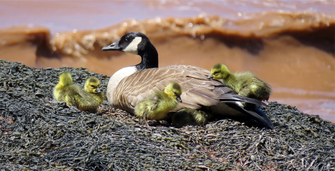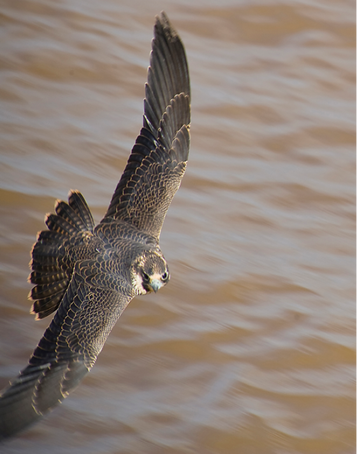
Imagine you’re walking along the ocean floor, enjoying all the usual sights that the Hopewell Rocks have to offer – the incoming tide, giant sea stacks, the tranquility of nature. Suddenly, out of the corner of your eye, you see what looks like a tennis ball fall out of the sky and land on the beach. Strange.

Of course, these aren’t tennis balls. The yellow, fluffy balls are goslings that have just made their terrifying descent from their nest fifty feet above onto the ocean floor—to the amazement of many onlookers.
When guests visit the Hopewell Rocks, they expect to see extraordinary tides and ancient rock formations. What might surprise visitors is the remarkable array of wildlife on display every single day.
Geese are just the tip of the iceberg for incredible scenes you’ll see within the park.
Walking down the site’s main walking trail, you’ll find black-capped chickadees, blue jays, and many other birds, same as you’ll find at the bird feeders in the yards of homes in Albert County. But some of the most amazing displays happen as you head towards the ocean floor.
If you visit the park at low tide and take a stroll down the beach, you might end up in Big Cove, where the park has a pair of nesting peregrine falcons. If you look to the skies, you’ll likely see one flying overhead, hunting for something to eat.
Fortunate guests might get to experience Dad catching lunch for his chicks, who usually hatch in early June, or perhaps later in the season you’ll even see a young peregrine learning the ropes and giving it a try. As the fastest birds in the world, reaching speeds of up to 320 km/h as they hunt; it’s a remarkable thing to witness, regardless of whether or not they are successful.
But if they're successful, the show gets better still.
After catching their prey, the two peregrines work together to get it back to the nest, with one bird flying upside-down underneath the other as they pass the food over using their talons—all while mid-air.
An encounter with a peregrine falcon always leaves guests amazed. The species was locally extinct in the Maritimes until their reintroduction through Fundy National Park.
Bring your gaze to sea level, and it might not look like there’s much going on in the water, but even there, there’s more than meets the eye.
While the muddy chocolate water of the Bay of Fundy doesn’t look like an appealing spot for ocean life, it isn’t uncommon to see a seal pop its head out of the water on a calm day to say hello or a porpoise fin diving in and out of the water.
There’s certainly plenty to see at the Hopewell Rocks— more than you might expect.
year working as an interpreter at the Hopewell Rocks. www.thehopewellrocks.ca
Photos by Kevin Snair.
 RSS Feed
RSS Feed